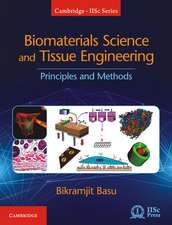The Cell as a Machine: Cambridge Texts in Biomedical Engineering
Autor Michael Sheetz, Hanry Yuen Limba Engleză Hardback – 10 ian 2018
Din seria Cambridge Texts in Biomedical Engineering
- 5%
 Preț: 397.76 lei
Preț: 397.76 lei - 5%
 Preț: 442.22 lei
Preț: 442.22 lei - 5%
 Preț: 573.97 lei
Preț: 573.97 lei - 5%
 Preț: 409.24 lei
Preț: 409.24 lei - 5%
 Preț: 689.10 lei
Preț: 689.10 lei - 5%
 Preț: 444.27 lei
Preț: 444.27 lei - 5%
 Preț: 522.90 lei
Preț: 522.90 lei - 11%
 Preț: 486.77 lei
Preț: 486.77 lei - 5%
 Preț: 905.93 lei
Preț: 905.93 lei -
 Preț: 441.45 lei
Preț: 441.45 lei - 5%
 Preț: 825.18 lei
Preț: 825.18 lei - 5%
 Preț: 872.98 lei
Preț: 872.98 lei - 5%
 Preț: 841.29 lei
Preț: 841.29 lei - 5%
 Preț: 874.27 lei
Preț: 874.27 lei - 5%
 Preț: 583.21 lei
Preț: 583.21 lei - 5%
 Preț: 845.07 lei
Preț: 845.07 lei - 11%
 Preț: 606.71 lei
Preț: 606.71 lei - 5%
 Preț: 654.54 lei
Preț: 654.54 lei - 5%
 Preț: 484.69 lei
Preț: 484.69 lei - 15%
 Preț: 530.76 lei
Preț: 530.76 lei
Preț: 621.35 lei
Preț vechi: 654.06 lei
-5% Nou
Puncte Express: 932
Preț estimativ în valută:
118.89€ • 124.47$ • 98.38£
118.89€ • 124.47$ • 98.38£
Carte tipărită la comandă
Livrare economică 07-21 aprilie
Preluare comenzi: 021 569.72.76
Specificații
ISBN-13: 9781107052734
ISBN-10: 1107052734
Pagini: 434
Ilustrații: 2 b/w illus. 136 colour illus.
Dimensiuni: 192 x 253 x 24 mm
Greutate: 1.1 kg
Editura: Cambridge University Press
Colecția Cambridge University Press
Seria Cambridge Texts in Biomedical Engineering
Locul publicării:New York, United States
ISBN-10: 1107052734
Pagini: 434
Ilustrații: 2 b/w illus. 136 colour illus.
Dimensiuni: 192 x 253 x 24 mm
Greutate: 1.1 kg
Editura: Cambridge University Press
Colecția Cambridge University Press
Seria Cambridge Texts in Biomedical Engineering
Locul publicării:New York, United States
Cuprins
Part I. Principle of Complex Function in Robust Machines: 1. Robust self-replicating machines shaped by evolution; 2. Complex functions of robust machines with emergent properties; 3. Integrated complex functions with dynamic feedback; 4. Cells exhibit multiple states, each with different functions; 5. Life at low Reynolds number and the mesoscale leads to stochastic phenomena; Part II. Design and Operation of Complex Functions: 6. Engineering lipid bilayers to provide fluid boundaries and mechanical controls; 7. Membrane trafficking – flow and barriers create asymmetries; 8. Signaling and cell volume control through ion transport and volume regulators; 9. Structuring a cell by cytoskeletal filaments; 10. Moving and maintaining functional assemblies with motors; 11. Microenvironment controls life, death and regeneration; 12. Adjusting cell shape and forces with dynamic filament networks; 13. DNA packaging for information retrieval and propagation; 14. Transcribing the right information and packaging for delivery; 15. Turning RNA into functional proteins and removing unwanted proteins; Part III. Coordination of Complex Functions: 16. How to approach a coordinated function – cell rigidity sensing and force generation across length scale; 17. Integration of cellular functions for decision making; 18. Moving from omnipotency to death; 19. Cancer versus regeneration – the wrong versus right response to the microenvironment.
Notă biografică
Descriere
A systematic and mathematically accessible introductory text explaining cell functions through the engineering principles of robust devices.























